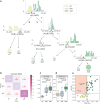Unveiling Resilience to Alzheimer's Disease: Insights From Brain Regional Proteomic Markers
- PMID: 37810186
- PMCID: PMC10557413
- DOI: 10.1177/26331055231201600
Unveiling Resilience to Alzheimer's Disease: Insights From Brain Regional Proteomic Markers
Abstract
Studying proteomics data of the human brain could offer numerous insights into unraveling the signature of resilience to Alzheimer's disease. In our previous study with rigorous cohort selection criteria that excluded 4 common comorbidities, we harnessed multiple brain regions from 43 research participants with 12 of them displaying cognitive resilience to Alzheimer's disease. Based on the previous findings, this work focuses on 6 proteins out of the 33 differentially expressed proteins associated with resilience to Alzheimer's disease. These proteins are used to construct a decision tree classifier, enabling the differentiation of 3 groups: (i) healthy control, (ii) resilience to Alzheimer's disease, and (iii) Alzheimer's disease with dementia. Our analysis unveiled 2 important regional proteomic markers: Aβ peptides in the hippocampus and PA1B3 in the inferior parietal lobule. These findings underscore the potential of using distinct regional proteomic markers as signatures in characterizing the resilience to Alzheimer's disease.
Keywords: Alzheimer’s disease; Proteomics; differential expression; mass spectrometry.
© The Author(s) 2023.
Conflict of interest statement
The author(s) declared no potential conflicts of interest with respect to the research, authorship, and/or publication of this article.
Figures

Comment on
-
Brain proteomic analysis implicates actin filament processes and injury response in resilience to Alzheimer's disease.Nat Commun. 2023 May 12;14(1):2747. doi: 10.1038/s41467-023-38376-x. Nat Commun. 2023. PMID: 37173305 Free PMC article.
References
-
- Breiman L, Friedman JH, Olshen RA, Stone CJ. Classification and Regression Trees. Chapman & Hall/CRC; 2017.
Publication types
Grants and funding
LinkOut - more resources
Full Text Sources

